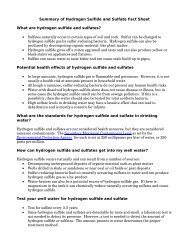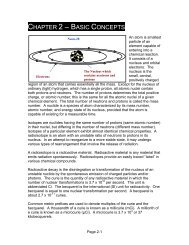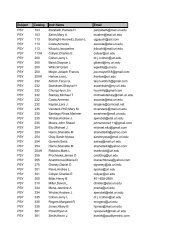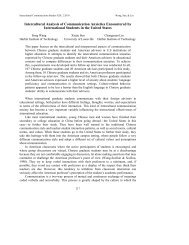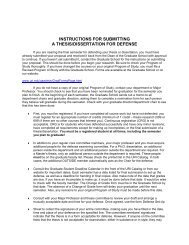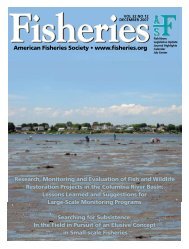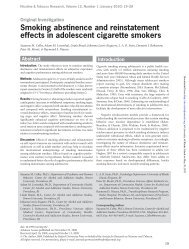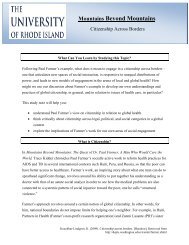- Page 1 and 2: United States Department of Agricul
- Page 4 and 5: Cover photo The scientific names fo
- Page 6 and 7: Rebecca G. Nisley editorial coordin
- Page 8: Introduction v How to Use This Book
- Page 13 and 14: Chapter 1 Seed Biology Franklin T.
- Page 15 and 16: Libocedrus (see Calocedrus) 313 Lig
- Page 17 and 18: Introduction 4 Flowering Plants 4 R
- Page 19 and 20: varied among species, ranging from
- Page 21 and 22: There are other effects of moisture
- Page 23 and 24: and Kirkman 1990). The flowers of m
- Page 25 and 26: Pollen grains of trees are extremel
- Page 27 and 28: common in forest species but has be
- Page 29 and 30: Table 2—Chapter 1, Seed Biology:
- Page 31 and 32: Figure 6—Chapter 1, Seed Biology:
- Page 33 and 34: Figure 9—Chapter 1, Seed Biology:
- Page 35 and 36: D. Don), ponderosa, digger (P. sabi
- Page 37 and 38: significant. Fowells and Schubert (
- Page 39 and 40: closed or only partly open, and see
- Page 41 and 42: seedcoats (Sandif 1988; Stubsgaard
- Page 43 and 44: Table 10—Chapter 1, Seed Biology:
- Page 45 and 46: (Bouvier-Durand and others 1984; Sa
- Page 47 and 48: Carl CM, Snow AG. 1971. Maturation
- Page 49 and 50: Martin GC, Dennis FG Jr, MacMillan
- Page 51 and 52: Vázquez-Yanes C, Orozco-Segovia A,
- Page 53 and 54: Chapter 2 Genetic Improvement of Fo
- Page 55 and 56: also replicated on different sites
- Page 57 and 58: The Genetic Code The physical basis
- Page 59 and 60:
have been operating for a number of
- Page 61 and 62:
Figure 3—Chapter 2, Genetic Impro
- Page 63 and 64:
dictates locations that cause a maj
- Page 65 and 66:
In the Western United States, seed
- Page 67 and 68:
The Pacific Northwest Tree improvem
- Page 69 and 70:
Abbott JE. 1974. Introgressive hybr
- Page 71 and 72:
Introduction 58 Harvesting 58 Plann
- Page 73 and 74:
Figure 1—Chapter 3, Seed Harvesti
- Page 75 and 76:
drop. This delay provides some marg
- Page 77 and 78:
Seed Acquisition Seed harvesting ca
- Page 79 and 80:
appearance could be due to the gene
- Page 81 and 82:
Those seeds that can be dried are r
- Page 83 and 84:
Figure 14—Chapter 3, Seed Harvest
- Page 85 and 86:
tightly they press against the shel
- Page 87 and 88:
However, before the wing is removed
- Page 89 and 90:
machine is determined by the speed
- Page 91 and 92:
large amount of pitch. The pitch pa
- Page 93 and 94:
damaged seedcoats. The seeds are pl
- Page 95 and 96:
Figure 40—Chapter 3, Seed Harvest
- Page 97 and 98:
Aldous JR. 1972. Nursery practice.
- Page 99 and 100:
Introduction 86 Factors Affecting L
- Page 101 and 102:
Table 1—Chapter 4, Storage of See
- Page 103 and 104:
drates and very little lipid. Even
- Page 105 and 106:
Table 7—Chapter 4, Storage of See
- Page 107 and 108:
Figure 4—Chapter 4, Storage of Se
- Page 109 and 110:
Barnett JP,Vozzo JA. 1985. Viabilit
- Page 111 and 112:
Chapter 5 Seed Testing Robert P. Ka
- Page 113 and 114:
Figure 1—Chapter 5, Seed Testing:
- Page 115 and 116:
gain or lose moisture in exchange w
- Page 117 and 118:
lot. “Inert matter” is all othe
- Page 119 and 120:
The germination test is conducted o
- Page 121 and 122:
A species that does not require pre
- Page 123 and 124:
daily germination increases with ea
- Page 125 and 126:
X-Radiography X-radiography is very
- Page 127 and 128:
seedling in a cell drops to .01, bu
- Page 129 and 130:
Anderson HW, Wilson BC. 1966. Impro
- Page 131 and 132:
Introduction 118 Certification in A
- Page 133 and 134:
Figure 2—Chapter 6, Certification
- Page 135 and 136:
(which varied only slightly from th
- Page 137 and 138:
seeds must receive a derogation (sp
- Page 139 and 140:
Introduction 126 Terminology 126 Th
- Page 141 and 142:
Figure 2—Chapter 7, Nursery Pract
- Page 143 and 144:
Genetic Considerations Most seedlin
- Page 145 and 146:
Table 1—Chapter 7, Nursery Practi
- Page 147 and 148:
wheel with clips to place the trans
- Page 149 and 150:
Soil Management and Seedbed Prepara
- Page 151 and 152:
Bareroot nurseries apply mineral nu
- Page 153 and 154:
Figure 14—Chapter 7, Nursery Prac
- Page 155 and 156:
1 seed per cavity. Although expensi
- Page 157 and 158:
Figure 18—Chapter 7, Nursery Prac
- Page 159 and 160:
Figure 20—Chapter 7, Nursery Prac
- Page 161 and 162:
Part II Specific Handling Methods a
- Page 163 and 164:
A Table 1—Abies, fir: nomenclatur
- Page 165 and 166:
A Table 1—Abies, fir: nomenclatur
- Page 167 and 168:
A 9 species—Pacific silver, balsa
- Page 169 and 170:
A Table 2—Abies, fir: schematic o
- Page 171 and 172:
A their validity is questionable (F
- Page 173 and 174:
A Guatemala have been reported (Agu
- Page 175 and 176:
A Thinning promoted fruiting in 150
- Page 177 and 178:
A Figure 5—Abies, fir: mature see
- Page 179 and 180:
A ber on the south side of the tree
- Page 181 and 182:
A Table 4—Abies, fir: insects aff
- Page 183 and 184:
A vigor (Laacke 1990a&b) and produc
- Page 185 and 186:
A detachment indicates that they ha
- Page 187 and 188:
A need turning at least once each d
- Page 189 and 190:
A The IDS (incubating-drying-separa
- Page 191 and 192:
A Table 9—Abies, fir: experiences
- Page 193 and 194:
A Table 10—Abies, fir: nursery pr
- Page 195 and 196:
A dried to 35% and refrigerated for
- Page 197 and 198:
A 1988). Tetrazolium test results o
- Page 199 and 200:
A 1989). Pesticide use changes over
- Page 201 and 202:
A Bergsten U. 1993. Removal of dead
- Page 203 and 204:
A Franklin JF. 1965. An exploratory
- Page 205 and 206:
A Irmak A. 1961. The seed-fall of f
- Page 207 and 208:
A MacLean DW. 1960. Some aspects of
- Page 209 and 210:
A Roe EI. 1948b. Balsam fir seed: i
- Page 211 and 212:
A Tulstrup NP. 1952. Skovfrø: nogl
- Page 213 and 214:
A Table 1—Acacia, acacia: nomencl
- Page 215 and 216:
A Table 4—Acacia, accacia: preger
- Page 217 and 218:
A Growth habit, occurrence, and use
- Page 219 and 220:
A found to be highly skewed to male
- Page 221 and 222:
A stands due to tree distribution a
- Page 223 and 224:
A the forest floor for at least 3 t
- Page 225 and 226:
A Table 5—Acer, maple: warm and c
- Page 227 and 228:
A Sometimes maple seedlings are lar
- Page 229 and 230:
A Van Gelderen DM, De Jong PC, Oter
- Page 231 and 232:
A Nursery practice. Although there
- Page 233 and 234:
A flower spikes are 15 to 20 cm tal
- Page 235 and 236:
A tures at 5 °C for about 120 days
- Page 237 and 238:
A Synonyms. Toxicodendron altissimu
- Page 239 and 240:
A Feret PP. 1985. Ailanthus: variat
- Page 241 and 242:
A Table 2—Albizia, albizia: pheno
- Page 243 and 244:
A Synonyms. Aleurites javanica Gand
- Page 245 and 246:
A Growth habit and occurrence. Alde
- Page 247 and 248:
A Table 1—Alnus, alder: nomenclat
- Page 249 and 250:
A Figure 2—Alnus, alder: nuts (se
- Page 251 and 252:
A Table 5—Alnus, alder: stratific
- Page 253 and 254:
A and early growth in the nursery (
- Page 255 and 256:
A Pojar J, MacKinnon A, comps. & ed
- Page 257 and 258:
A als by Kay and others (1988) refe
- Page 259 and 260:
A Table 2—Amelanchier, serviceber
- Page 261 and 262:
A tions (Acharya and others 1989).
- Page 263 and 264:
A Growth habit, occurrence, and use
- Page 265 and 266:
A Figure 2—Amorpha canescens, lea
- Page 267 and 268:
A be taken when lifting, as the roo
- Page 269 and 270:
A 1981). A distinguishing character
- Page 271 and 272:
A Figure 4—Aralia nudicaulis, wil
- Page 273 and 274:
A to 27 years old and are about 20
- Page 275 and 276:
A should be treated with a fungicid
- Page 277 and 278:
A Figure 2—Arbutus menziesii, Pac
- Page 279 and 280:
A Growth habit, occurrence, and use
- Page 281 and 282:
A may be checked in the field by cu
- Page 283 and 284:
A Keeley JE. 1995. Seed germination
- Page 285 and 286:
A Table 2—Aronia, chokeberry: phe
- Page 287 and 288:
A Growth habit, occurrence, and use
- Page 289 and 290:
A the exterior of the pericarp may
- Page 291 and 292:
A others 1959; Wilson 1982) probabl
- Page 293 and 294:
A Wagstaff FJ, Welch BL. 1991. Seed
- Page 295 and 296:
A soundness are as follows (Bonner
- Page 297 and 298:
A Table 1—Atriplex, saltbush: eco
- Page 299 and 300:
A Figure 2—Atriplex semibaccata,A
- Page 301 and 302:
A ole walls may also be weakened by
- Page 303 and 304:
A Gerard JB. 1978. Factors affectin
- Page 305 and 306:
B Table 1—Baccharis, baccharis: n
- Page 307 and 308:
B Table 3 —Baccharis, baccharis:
- Page 309 and 310:
B Table 2—Bauhinia, bauhinia: flo
- Page 311 and 312:
B Berberidaceae—Barberry family G
- Page 313 and 314:
B Table 2—Berberis, barberry: phe
- Page 315 and 316:
B Ahrendt T. 1961. Berberis and Mah
- Page 317 and 318:
B Table 1—Betula, birch: nomencla
- Page 319 and 320:
B Figure 1—Betula, birch: ripe fe
- Page 321 and 322:
B Table 5—Betula, birch: germinat
- Page 323 and 324:
B References Ahlgren CE.1957. Pheno
- Page 325 and 326:
C seeds sink in water, and the pulp
- Page 327 and 328:
C the winter and early spring...”
- Page 329 and 330:
C Reported averages representing co
- Page 331 and 332:
C McDonald PM. 1992. Estimating see
- Page 333 and 334:
C 10 °C is recommended for quick a
- Page 335 and 336:
C Figure 3—Caragana arborsecens,
- Page 337 and 338:
C Cactaceae Cactus family Carnegiea
- Page 339 and 340:
C Growth habit. Carpenteria (bush-a
- Page 341 and 342:
C Growth habit, occurrence, and use
- Page 343 and 344:
C Table 2—Carpinus, carpinus: phe
- Page 345 and 346:
C Allen DH. 1995. Personal communic
- Page 347 and 348:
C Table 2—Carya, hickory: phenolo
- Page 349 and 350:
C imbibed nuts in plastic bags with
- Page 351 and 352:
C Growth habit, occurrence, and use
- Page 353 and 354:
C is especially important if the we
- Page 355 and 356:
C Growth habit, occurrence, and use
- Page 357 and 358:
C Nursery practice. In the nursery,
- Page 359 and 360:
C Figure 1—Catalpa bignonioides,
- Page 361 and 362:
C Growth habit, occurrence, and use
- Page 363 and 364:
C Figure 1—Ceanothus, ceanothus:
- Page 365 and 366:
C Table 3—Ceanothus, ceanothus: t
- Page 367 and 368:
C stimulate germination. For wester
- Page 369 and 370:
C Poth M, Barro SC. 1986. On the th
- Page 371 and 372:
C seeds (table 2) (Dirr 1990; Farjo
- Page 373 and 374:
C temperatures of 20 °C (night) an
- Page 375 and 376:
C Hartmann HT, Kester DE, Davies FT
- Page 377 and 378:
C Extraction and storage of seeds.
- Page 379 and 380:
C Growth habit, occurrence, and use
- Page 381 and 382:
C Table 3—Celtis, hackberry: heig
- Page 383 and 384:
C Germination tests. Buttonbush see
- Page 385 and 386:
C Figure 1—Ceratonia siliqua, car
- Page 387 and 388:
C Growth habit, occurrence, and use
- Page 389 and 390:
C Figure 1—Cercis canadensis, eas
- Page 391 and 392:
C whether to dip the seeds for 15 o
- Page 393 and 394:
C Jones RO, Geneve RL. 1995. Seedco
- Page 395 and 396:
C ledifolius is more shrubby (or le
- Page 397 and 398:
C Nursery and field practice. Curll
- Page 399 and 400:
C Adams RS. 1969. How to cure mount
- Page 401 and 402:
C Rosoideae). McArthur and Sanderso
- Page 403 and 404:
C Kirkwood JE. 1930. Northern Rocky
- Page 405 and 406:
C Table 2—Chamaecyparis, white-ce
- Page 407 and 408:
C Table 4—Chamaecyparis, white-ce
- Page 409 and 410:
C 396 • Woody Plant Seed Manual B
- Page 411 and 412:
C Growth habit, occurrence, and use
- Page 413 and 414:
C zomes. Cultivation attempts often
- Page 415 and 416:
C Figure 2—Chionanthus virginicus
- Page 417 and 418:
C Synonyms. The 2 species of Chryso
- Page 419 and 420:
C Figure 3—Chrysolepsis, chinquap
- Page 421 and 422:
C Table 1—Chrysothamnus, rabbitbr
- Page 423 and 424:
C Table 2—Chrysothamnus, rabbitbr
- Page 425 and 426:
C Anderson LC. 1986. An overview of
- Page 427 and 428:
C Figure 1—Cladrastis kentukea, y
- Page 429 and 430:
C Dates of flowering and fruiting a
- Page 431 and 432:
C Table 5—Clematis, clematis: ger
- Page 433 and 434:
C have been observed (Bir 1992b). T
- Page 435 and 436:
C 422 • Woody Plant Seed Manual R
- Page 437 and 438:
C Figure 3—Coleogyne ramosissima,
- Page 439 and 440:
C Growth habit, occurrence, and use
- Page 441 and 442:
C Growth habit, occurrence, and use
- Page 443 and 444:
C Table 2—Cornus, dogwood: phenol
- Page 445 and 446:
C and sow them in the spring (Goodw
- Page 447 and 448:
C Other common names. Filbert, haze
- Page 449 and 450:
C carried out on the nature of dorm
- Page 451 and 452:
C 438 • Woody Plant Seed Manual A
- Page 453 and 454:
C Table 2—Cotinus, smoketree: see
- Page 455 and 456:
C Growth habit, occurrence, and use
- Page 457 and 458:
C Table 2—Cotoneaster, cotoneaste
- Page 459 and 460:
C (Shaw and others 2004). Germinati
- Page 461 and 462:
C Table 1—Crataegus, hawthorn: no
- Page 463 and 464:
C edible fruits in Asia, Central Am
- Page 465 and 466:
C Figure 1—Crataegus, hawthorn: c
- Page 467 and 468:
C recommended that if controlled se
- Page 469 and 470:
C Flint HL. 1997. Landscape plants
- Page 471 and 472:
C Figure 2—Cryptomeria japonica,
- Page 473 and 474:
C Table 1—Cupressus, cypress: nom
- Page 475 and 476:
C Table 3—Cupressus, cypress: see
- Page 477 and 478:
C Table 4—Cupressus, cypress: ger
- Page 479 and 480:
C Growth habit, occurrence, and use
- Page 481 and 482:
D Fabaceae—Pea family Delonix reg
- Page 483 and 484:
D Growth habit, occurrence, and use
- Page 485 and 486:
D Growth habit, occurrence, and use
- Page 487 and 488:
D screen cleaner to remove trash an
- Page 489 and 490:
D 476 • Woody Plant Seed Manual T
- Page 491 and 492:
D anthers still contained pollen in
- Page 493 and 494:
D Figure 6—Dirca palustris, easte
- Page 495 and 496:
E Fabaceae—Pea family Ebenopsis e
- Page 497 and 498:
E Growth habit, occurrence, and use
- Page 499 and 500:
E Table 3—Elaeagnus, elaeagnus: h
- Page 501 and 502:
E Other common names. brittlebush,
- Page 503 and 504:
E Fabaceae—Pea family Enterolobiu
- Page 505 and 506:
E Growth habit, occurrence, and use
- Page 507 and 508:
E Figure 2—Ephedra viridis,Torrey
- Page 509 and 510:
E Germination tests. Germination is
- Page 511 and 512:
E Germination. Parish goldenweed se
- Page 513 and 514:
E Table 1— Eriogonum, wild-buckwh
- Page 515 and 516:
E Table 2—Eriogonum, wild-buckwhe
- Page 517 and 518:
E Growth habit, occurrence, and use
- Page 519 and 520:
E fall; and tallowwood eucalyptus i
- Page 521 and 522:
E Table 4—Eucalyptus, eucalyptus:
- Page 523 and 524:
E Table 7—Eucalyptus, eucalyptus:
- Page 525 and 526:
E Geary TF, Meskimen GF, Franklin E
- Page 527 and 528:
E Table 2— Euonymus, euonymus: he
- Page 529 and 530:
E Figure 3—Euonymus, euonymus: se
- Page 531 and 532:
E Table 8—Euonymus, euonymus: ger
- Page 533 and 534:
F Fagaceae—Beech family Fagus L.
- Page 535 and 536:
F Table 3—Fagus, beech: height, s
- Page 537 and 538:
F Ahuja MR. 1986. Short note: stora
- Page 539 and 540:
F Figure 2—Fallugia paradoxa, Apa
- Page 541 and 542:
F Synonym. Flindersia chatawaiana F
- Page 543 and 544:
F 530 • Woody Plant Seed Manual R
- Page 545 and 546:
F Table 1—Frangula, buckthorn: no
- Page 547 and 548:
F Arno SF, Hammerly RP. 1977. North
- Page 549 and 550:
F Figure 2—Franklinia alatamaha,
- Page 551 and 552:
F Deusen and Cunningham 1982), and
- Page 553 and 554:
F Table 4—Fraxinus, ash: seed yie
- Page 555 and 556:
F Table 6—Fraxinus, ash: germinat
- Page 557 and 558:
F Growth habit, occurrence, and use
- Page 559 and 560:
F because the period of germination
- Page 561 and 562:
G Table 1—Garrya, silktassel: occ
- Page 563 and 564:
G Growth habit, occurrence, and use
- Page 565 and 566:
G Table 2—Gaultheria, wintergreen
- Page 567 and 568:
G stratified and sown in the spring
- Page 569 and 570:
G McMinn HE. 1970. An illustrated m
- Page 571 and 572:
G Germination. Black huckleberry se
- Page 573 and 574:
G Figure 2—Ginkgo biloba, ginkgo:
- Page 575 and 576:
G Growth habit and uses. There are
- Page 577 and 578:
G the acid treatment has been much
- Page 579 and 580:
G Figure 3—Gordonia lasianthus, l
- Page 581 and 582:
G consists of a single pistil enclo
- Page 583 and 584:
G Wallace and Romney 1972; Wood and
- Page 585 and 586:
G Everett RL,Tueller PT, Davis JB,
- Page 587 and 588:
G Figure 1—Grevillea robusta, sil
- Page 589 and 590:
G Figure 2—Gutierrezia sarothrae,
- Page 591 and 592:
G Growth habit, occurrence, and use
- Page 593 and 594:
H Other common names. opossum-wood,
- Page 595 and 596:
H Growth habit, occurrence, and use
- Page 597 and 598:
H Nursery practice. Witch-hazel see
- Page 599 and 600:
H Figure 2—Heteromeles arbutifoli
- Page 601 and 602:
H Other common names. Sandthorn, sw
- Page 603 and 604:
H Papp L. 1982. The importance of v
- Page 605 and 606:
H (Stark 1966; Sutton and Johnson 1
- Page 607 and 608:
H Creambush ocean-spray can be esta
- Page 609 and 610:
H Figure 2—Hymenaea courbaril, co
- Page 611 and 612:
I Table 2—Ilex, holly: phenology
- Page 613 and 614:
I Afanasiev M. 1942. Propagation of
- Page 615 and 616:
J cultural varieties of English and
- Page 617 and 618:
J often spread on the ground in the
- Page 619 and 620:
J Beineke WF. 1989. Twenty years of
- Page 621 and 622:
J Table 1—Juniperus, juniper: nom
- Page 623 and 624:
J Table 3—Juniperus, juniper: hei
- Page 625 and 626:
J Nursury practices. Juniper seeds
- Page 627 and 628:
J Johnsen TN Jr, Alexander RA. 1974
- Page 629 and 630:
K (Jaynes 1997). An individual shru
- Page 631 and 632:
K 618 • Woody Plant Seed Manual A
- Page 633 and 634:
K Growth habit, occurrence, and use
- Page 635 and 636:
K temperature and longer in cold st
- Page 637 and 638:
K Growth habit, occurrence, and use
- Page 639 and 640:
K Synonyms. Eurotia lanata (Pursh)
- Page 641 and 642:
K Table 1— Krascheninnikovia lana
- Page 643 and 644:
K Pursh F. 1814. Flora Americae Sep
- Page 645 and 646:
L Figure 1—Laburnum anagyroides,
- Page 647 and 648:
L 634 • Woody Plant Seed Manual L
- Page 649 and 650:
L Pregermination treatments and ger
- Page 651 and 652:
L fall. Branching is usually pyrami
- Page 653 and 654:
L The seed cones and pollen cones u
- Page 655 and 656:
L Atmospheric fluorides can reduce
- Page 657 and 658:
L larch seeds keep well for a year
- Page 659 and 660:
L Table 8—Larix, larch: germinati
- Page 661 and 662:
L Eis S, Craigdallie D. 1983. Larch
- Page 663 and 664:
L Simak M. 1973. Separation of fore
- Page 665 and 666:
L Figure 2—Larrea tridentata, cre
- Page 667 and 668:
L Figure 1—Ledum groenlandiicum,
- Page 669 and 670:
L 1980) ripens seeds a month earlie
- Page 671 and 672:
L Fabaceae—Pea family Leucaena le
- Page 673 and 674:
L Brewbaker JL, Plucknett DL, Gonza
- Page 675 and 676:
L Figure 2—Leucothoe fontanesiana
- Page 677 and 678:
L The privets are valued for landsc
- Page 679 and 680:
L AFA [American Forestry Associatio
- Page 681 and 682:
L Figure 1—Lindera benzoin, commo
- Page 683 and 684:
L 670 • Woody Plant Seed Manual H
- Page 685 and 686:
L Table 1—Liquidambar styraciflua
- Page 687 and 688:
L 674 • Woody Plant Seed Manual M
- Page 689 and 690:
L Table 1—Liriodendron tulipifera
- Page 691 and 692:
L Fagaceae—Beech family Lithocarp
- Page 693 and 694:
L spring. Seeding germinated acorns
- Page 695 and 696:
L Occurrence, growth habit, and use
- Page 697 and 698:
L Table 1—Lonicera, honeysuckle:
- Page 699 and 700:
L Figure 2—Lonicera, honeysuckle:
- Page 701 and 702:
L Bailey LH. 1949. Manual of cultiv
- Page 703 and 704:
L as they have stored well in seale
- Page 705 and 706:
L Figure 1—Lupinus, lupine: seeds
- Page 707 and 708:
L Other common names. matrimony vin
- Page 709 and 710:
L Figure 2—Lycium barbarum, matri
- Page 711 and 712:
M Figure 1—Maclura pomifera, Osag
- Page 713 and 714:
M The genus Magnolia comprises abou
- Page 715 and 716:
M Magnolias have the most primitive
- Page 717 and 718:
M Nursery practice. Sowing seeds in
- Page 719 and 720:
M 706 • Woody Plant Seed Manual B
- Page 721 and 722:
M Figure 2—Mahonia, Oregon-grape:
- Page 723 and 724:
M the distal end, and incubating in
- Page 725 and 726:
M Rosaceae—Rose family Malus Mill
- Page 727 and 728:
M Table 2—Malus, apple: phenology
- Page 729 and 730:
M significant impacts on both the p
- Page 731 and 732:
M Meliaceae—Mahogany family Melia
- Page 733 and 734:
M Menispermaceae—Moonseed family
- Page 735 and 736:
M related sub-shrub, was improved b
- Page 737 and 738:
M ing at room temperature. Tumbling
- Page 739 and 740:
M Growth habit, occurrence, and use
- Page 741 and 742:
M Moraceae—Mulberry family Morus
- Page 743 and 744:
M Figure 2—Morus alba, white mulb
- Page 745 and 746:
M Table 4—Morus, mulberry: seed y
- Page 747 and 748:
M deciduous or evergreen shrubs and
- Page 749 and 750:
M However, germination was reduced
- Page 751 and 752:
N Hydrophyllaceae—Waterleaf famil
- Page 753 and 754:
N Other common names. heavenly-bamb
- Page 755 and 756:
N References Afanasiev M. 1943. Ger
- Page 757 and 758:
N (Adams 1927; Schopmeyer 1974). Co
- Page 759 and 760:
N Figure 1—Nyssa, tupelo: fruits
- Page 761 and 762:
N Figure 4—Nyssa sylvatica, black
- Page 763 and 764:
O Flowering and Fruiting. Anatomica
- Page 765 and 766:
O Abrams L. 1944. Illustrated flora
- Page 767 and 768:
O Figure 1—Olea europaea, olive:
- Page 769 and 770:
O Table 1—Olea europaea, olive: f
- Page 771 and 772:
O counts on 2 samples were 4,400 an
- Page 773 and 774:
O Figure 2—Ostrya virginiana, eas
- Page 775 and 776:
O Figure 1—Oxydendron arboreum, s
- Page 777 and 778:
P Fabaceae—Pea family Paraseriant
- Page 779 and 780:
P Growth habit, occurrence, and use
- Page 781 and 782:
P Figure 2—Parkinsonia aculeata,
- Page 783 and 784:
P Figure 1—Parthenocissus quinque
- Page 785 and 786:
P Other common names. paulownia, em
- Page 787 and 788:
P Growth habit, occurrence, and use
- Page 789 and 790:
P Table 3—Penstemon, penstemon, b
- Page 791 and 792:
P 778 • Woody Plant Seed Manual R
- Page 793 and 794:
P Auger J. 1994. Viability and germ
- Page 795 and 796:
P Figure 3—Persea borbonia, redba
- Page 797 and 798:
P Figure 3—Phellodendron amurense
- Page 799 and 800:
P Growth habit, occurrence, and use
- Page 801 and 802:
P Collection, cleaning, and storage
- Page 803 and 804:
P 790 • Woody Plant Seed Manual R
- Page 805 and 806:
P Figure 2—Physocarpus malvaceus,
- Page 807 and 808:
P Table 1—Picea, spruce: nomencla
- Page 809 and 810:
P (Diebel and Fechner 1988; Fechner
- Page 811 and 812:
P Figure 2—Picea glauca, white sp
- Page 813 and 814:
P Table 3—Picea, spruce: common c
- Page 815 and 816:
P Table 4—Picea, spruce: weight o
- Page 817 and 818:
P emergence rate of white spruce se
- Page 819 and 820:
P Ross SD. 1992. Promotion of flowe
- Page 821 and 822:
P Figure 1—Pieris floribunda, mou
- Page 823 and 824:
P Table 1— Pinus, pine: nomenclat
- Page 825:
P Table 1— Pinus, pine: nomenclat
- Page 828 and 829:
Table 2 —Pinus, pine: mature tree
- Page 830 and 831:
the 2-needle form, var. edulis. Mor
- Page 832 and 833:
Pinus parviflora—Japanese white p
- Page 834 and 835:
Guatemala, the var. chiapensis Mart
- Page 836 and 837:
Table 3—Pinus, pine: phenology of
- Page 838 and 839:
Table 4—Pinus, pine: cone ripenes
- Page 840 and 841:
Figure 2A—Pinus, pine: seeds (alt
- Page 842 and 843:
Table 5—Pinus, pine: specific gra
- Page 844 and 845:
Table 6—Pinus, pine: cone process
- Page 846 and 847:
Table 8—Pinus, pine: cone and see
- Page 848 and 849:
Table 9—Pinus, pine: recommended
- Page 850 and 851:
Table 10—Pinus, pine: seed germin
- Page 852 and 853:
Figure 4—Pinus resinosa, red pine
- Page 854 and 855:
losses to birds and rodents, and th
- Page 856 and 857:
Cocozza MA. 1961. Osservazioni sul
- Page 858 and 859:
Lamb GN. 1915. A calendar of the le
- Page 860 and 861:
Steinhoff RJ. 1964. Taxonomy, nomen
- Page 862 and 863:
Figure 2—Pithecellobium dulce, gu
- Page 864 and 865:
core. The elongated embryo is surro
- Page 866 and 867:
Nursery practice. Sycamores are usu
- Page 868 and 869:
tained for at least 5 years. For lo
- Page 870 and 871:
Table 1—Populus, poplar, cottonwo
- Page 872 and 873:
Flowering and fruiting. Poplars are
- Page 874 and 875:
nificant number of flowers from the
- Page 876 and 877:
Figure 3—Populus balsamifera, bal
- Page 878 and 879:
Table 5—Populus, poplar, cottonwo
- Page 880 and 881:
Figure 6—Populus, poplar: stages
- Page 882 and 883:
Andrejak GE, Barnes BV. 1969. A see
- Page 884 and 885:
Tauer CG. 1995. Unpublished data. S
- Page 886 and 887:
Figure 2—Prosopis juliflora, mesq
- Page 888 and 889:
Growth habit, occurrence, and use.
- Page 890 and 891:
Table 1—Prunus, cherry, peach, an
- Page 892 and 893:
Table 2—Prunus, cherry, peach, an
- Page 894 and 895:
Table 3—Prunus, cherry, peach, an
- Page 896 and 897:
Tables 5—Prunus, cherry, peach, a
- Page 898 and 899:
Table 6—Prunus, cherry, peach, an
- Page 900 and 901:
Figure 5—Prunus virginianna, comm
- Page 902 and 903:
Crocker W. 1927. Dormancy in hybrid
- Page 904 and 905:
Growth habit, occurrence, and uses.
- Page 906 and 907:
Table 2—Pseudotsuga, Douglas-fir:
- Page 908 and 909:
Table 3—Pseudotsuga, Douglas-fir:
- Page 910 and 911:
mended (table 4), as high heat appl
- Page 912 and 913:
Ching 1959; Dumroese and others 198
- Page 914 and 915:
stored at -7 to 3 °C for 9 months
- Page 916 and 917:
Borno C,Taylor IEP. 1975. The effec
- Page 918 and 919:
Myers JF, Howe GE. 1990. Vegetative
- Page 920 and 921:
Other common names. dalea. Growth h
- Page 922 and 923:
Table 2—Psorothamnus, indigobush:
- Page 924 and 925:
Figure 2— Ptelea trifoliata, comm
- Page 926 and 927:
Growth habit, occurrence, and use.
- Page 928 and 929:
Chudnoff M. 1984. Tropical timbers
- Page 930 and 931:
Kyle and Righetti 1996; Nelson 1983
- Page 932 and 933:
warm water (>10 °C), or holding im
- Page 934 and 935:
McCarty EC, Price R. 1942. Growth a
- Page 936 and 937:
Table 1— Pyrus, pear: nomenclatur
- Page 938 and 939:
Figure 1—Pyrus, pear: fruit and s
- Page 940 and 941:
Seedlings of wild native species ar
- Page 942 and 943:
Figure 1— Quercus, oak: acorns of
- Page 944 and 945:
Table 1—Quercus, oak: nomenclatur
- Page 946 and 947:
Table 2—Quercus, oak: height, see
- Page 948 and 949:
ing does not prevent sowing or prod
- Page 950 and 951:
Figure 3—Quercus macrocarpa, bur
- Page 952 and 953:
Growth habit, occurrence, and use.
- Page 954 and 955:
Figure 2—Rhamnus cathartica, Euro
- Page 956 and 957:
Occurrence. The genus rhododendron
- Page 958 and 959:
Table 1—Rhododendron, rhododendro
- Page 960 and 961:
Figure 1—Rhododendron, rhododendr
- Page 962 and 963:
Table 4—Rhododendron, rhododendro
- Page 964 and 965:
eduction in leaf, stem, and root dr
- Page 966 and 967:
Figure 2—Rhodotypos scandens, jet
- Page 968 and 969:
Table 1—Rhus, sumac; Toxicodendro
- Page 970 and 971:
Figure 1—Rhus, sumac: fruits of R
- Page 972 and 973:
Figure 4—Rhus hirta, staghorn sum
- Page 974 and 975:
Grossulariaceae—Currant family Ri
- Page 976 and 977:
Table 2—Ribes, currant, gooseberr
- Page 978 and 979:
empty seeds, and excess water can t
- Page 980 and 981:
investigators alternated diurnal te
- Page 982 and 983:
Growth habit, occurrence, and use.
- Page 984 and 985:
Figure 1—Robinia, locust: legumes
- Page 986 and 987:
( 1 / 4 in) of soil, as in the nurs
- Page 988 and 989:
example is the multiflora rose, a J
- Page 990 and 991:
the sutures, whether with acid or t
- Page 992 and 993:
The preferred method in official te
- Page 994 and 995:
Arecaceae—Palm family Roystonea O
- Page 996 and 997:
Collection, storage, and germinatio
- Page 998 and 999:
Table 1—Rubus, blackberry, raspbe
- Page 1000 and 1001:
seeds without sexual reproduction)
- Page 1002 and 1003:
flowering and fruit ripening usuall
- Page 1004 and 1005:
Table 5—Rubus, blackberry, raspbe
- Page 1006 and 1007:
Some form of sulfuric acid treatmen
- Page 1008 and 1009:
seeds have germinated and reached a
- Page 1010 and 1011:
Arecaceae—Palm family Sabal Adans
- Page 1012 and 1013:
Table 2—Sabal, palmetto: seed dat
- Page 1014 and 1015:
Table 1—Salix, willow: nomenclatu
- Page 1016 and 1017:
Booth willow, 6 to 9; pussy willow,
- Page 1018 and 1019:
Table 3—Salix, willow: phenology
- Page 1020 and 1021:
Table 4—Salix, willow: cleaned se
- Page 1022 and 1023:
Kim KH, Zsuffa L, Kenny A, Mosseler
- Page 1024 and 1025:
Figure1—Salvia sonomensis, creepi
- Page 1026 and 1027:
ANPS [Arizona Native Plant Society]
- Page 1028 and 1029:
Figure 1—Sambucus nigra spp. ceru
- Page 1030 and 1031:
Table 5—Sambucus, elder: stratifi
- Page 1032 and 1033:
Sapindaceae—Soapberry family Sapi
- Page 1034 and 1035:
Afanasiev M. 1942. Propagation of t
- Page 1036 and 1037:
Figure 2—Sarcobatus vermiculatus,
- Page 1038 and 1039:
Synonyms. Sassafras albidum var. mo
- Page 1040 and 1041:
Growth habit, occurrence, and use.
- Page 1042 and 1043:
Anderson E. 2002. Personal communic
- Page 1044 and 1045:
1930; Rehder 1940; Waxman 1957). Wa
- Page 1046 and 1047:
perature, 4 °C, -15 °C, and in wa
- Page 1048 and 1049:
Figure 1—Sequoia sempervirens, re
- Page 1050 and 1051:
Taxodiaceae—Redwood family Sequoi
- Page 1052 and 1053:
Arecaceae—Palm family Serenoa rep
- Page 1054 and 1055:
Figure 1—Serenoa repens, saw-palm
- Page 1056 and 1057:
Growth habit, occurrence, and use.
- Page 1058 and 1059:
The seeds are orthodox and should b
- Page 1060 and 1061:
Sapotaceae—Sapodilla family Sider
- Page 1062 and 1063:
Simmondsiaceae—Jojoba family Simm
- Page 1064 and 1065:
(Castellanos and Molina 1990). Dorm
- Page 1066 and 1067:
Figure 1—Solanum dulcamara, bitte
- Page 1068 and 1069:
Growth habit, occurrence and use. T
- Page 1070 and 1071:
Rosaceae—Rose family Sorbaria sor
- Page 1072 and 1073:
Growth habit, occurrence, and uses.
- Page 1074 and 1075:
Figure 2—Sorbus, mountain-ash: tw
- Page 1076 and 1077:
Table 5—Sorbus, mountain-ash: str
- Page 1078 and 1079:
Bignoniaceae—Trumpet-creeper fami
- Page 1080 and 1081:
Growth habit, occurrence, and uses.
- Page 1082 and 1083:
ecomes straw-colored or light brown
- Page 1084 and 1085:
Growth habit, occurrence and use. T
- Page 1086 and 1087:
However, recent research results in
- Page 1088 and 1089:
Growth habit, occurrence and use. T
- Page 1090 and 1091:
Figure 3—Swietenia, mahogany: ger
- Page 1092 and 1093:
used by birds and black bear (Ursus
- Page 1094 and 1095:
22 to 30 °C for 3 to 4 months has
- Page 1096 and 1097:
Growth habit, occurrence, and use.
- Page 1098 and 1099:
In common, nodding (S. reflexa C.K.
- Page 1100 and 1101:
Synonym. T. pentrandra Pall. Growth
- Page 1102 and 1103:
Growth habit, occurrence, and use.
- Page 1104 and 1105:
at 4 °C for 90 days or until ready
- Page 1106 and 1107:
Pacific yew is common east of the C
- Page 1108 and 1109:
number of cleaned seeds per weight
- Page 1110 and 1111:
efore they are of salable size (Har
- Page 1112 and 1113:
Growth habit, occurrence, and use.
- Page 1114 and 1115:
are more difficult to germinate (Tr
- Page 1116 and 1117:
poisonous to sheep, especially smoo
- Page 1118 and 1119:
Malvaceae—Mallow family Thespesia
- Page 1120 and 1121:
Francis JK. 1989. Thespesia grandif
- Page 1122 and 1123:
The 3 Asian species listed (table 1
- Page 1124 and 1125:
Figure 4—Thuja occidentalis, nort
- Page 1126 and 1127:
Tiliaceae—Linden family Tilia L.
- Page 1128 and 1129:
weather conditions) and lack of con
- Page 1130 and 1131:
good germination for all species an
- Page 1132 and 1133:
Synonyms. Toona australis Harms, Ce
- Page 1134 and 1135:
Growth habit, occurrence, and uses.
- Page 1136 and 1137:
then held in open storage until the
- Page 1138 and 1139:
Euphorbiaceae—Spurge family Triad
- Page 1140 and 1141:
Growth habit, occurrence, and use.
- Page 1142 and 1143:
can trap more than 100 pollen grain
- Page 1144 and 1145:
Figure 3—Tsuga mertensiana, mount
- Page 1146 and 1147:
Table 6—Tsuga, hemlock: stratific
- Page 1148 and 1149:
or equal to 0.05) (Edwards and El-K
- Page 1150 and 1151:
continue height growth during the s
- Page 1152 and 1153:
Ruth RH. 1974. Tsuga, hemlock. In:
- Page 1154 and 1155:
The mature fruit is a typical, smal
- Page 1156 and 1157:
Growth habit, occurrence, and use.
- Page 1158 and 1159:
Figure 1—Ulmus, elm: samaras of U
- Page 1160 and 1161:
months (Dirr and Heuser 1987). Seed
- Page 1162 and 1163:
Arisumi T, Harrison JM. 1961. The g
- Page 1164 and 1165:
leaves, and seeds have been sold fo
- Page 1166 and 1167:
Seedling development and nursery pr
- Page 1168 and 1169:
Table 1—Vaccinium, blueberry and
- Page 1170 and 1171:
seeds are allowed to dry (Ballingto
- Page 1172 and 1173:
Figure 3—Vaccinium corymbosum, hi
- Page 1174 and 1175:
Germination. No pretreatments are u
- Page 1176 and 1177:
European cranberrybush are eaten by
- Page 1178 and 1179:
Table 3—Viburnum, viburnum: growt
- Page 1180 and 1181:
Table 6—Viburnum, viburnum: lates
- Page 1182 and 1183:
Figure 1—Vitex agnus-castus, lila
- Page 1184 and 1185:
Other common names. northern fox gr
- Page 1186 and 1187:
Arecaceae—Palm family Washingtoni
- Page 1188 and 1189:
Growth habit and occurrence. There
- Page 1190 and 1191:
Table 2—Yucca, yucca: phenology o
- Page 1192 and 1193:
Seedlings should be provided with m
- Page 1194 and 1195:
Figure 2—Zanthoxylum clava-hercul
- Page 1196 and 1197:
Rhamnaceae—Buckthorn family Zizip
- Page 1198 and 1199:
Chenopodiaceae—Goosefoot family Z
- Page 1200 and 1201:
Figure 3—Zuckia brandegei, siltbu
- Page 1202 and 1203:
Gray A. 1876. Grayia brandegei. Pro
- Page 1204 and 1205:
Conversion Factors 1192 Glossary 11
- Page 1206 and 1207:
abortive imperfectly or incompletel
- Page 1208 and 1209:
fruit wall outer layer of fruits in
- Page 1210 and 1211:
polygamo-monoecious species that ar
- Page 1212 and 1213:
A Aceraceae—Maple family Acer L.
- Page 1214 and 1215:
S Salicaceae—Willow family Populu
- Page 1216 and 1217:
C Connor, Kristina F. Bauhinia Park
- Page 1218 and 1219:
Schubert, T. H. Tectona Shaw, Nancy
- Page 1220 and 1221:
auline blanchâtre, Alnus Australia
- Page 1222 and 1223:
Carolina silverbell, Halesia carpen
- Page 1224 and 1225:
Douglas-spruce, Pseudotsuga droopin
- Page 1226 and 1227:
hackmatack, Larix hackmatack, Popul
- Page 1228 and 1229:
Scotch Waterer lacewood, Grevillea
- Page 1230 and 1231:
interior live iron jack Kellogg lau
- Page 1232 and 1233:
western white western yellow Weymou
- Page 1234 and 1235:
silk-oak, Grevillea silktassel, Gar
- Page 1236 and 1237:
Hinds Hinds black Japanese little n
- Page 1238 and 1239:
Figure 1—Cercidium floridum Figur
- Page 1240 and 1241:
Figure 13—Thespesia populnea Figu



